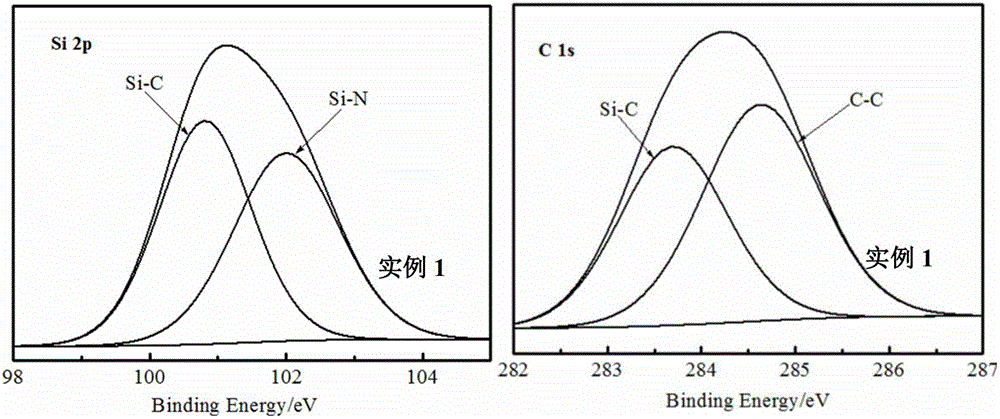Preparing method of silicon-carbon-nitrogen wave absorbing ceramic base composite materials
A composite material and ceramic-based technology, which is applied in the field of in-situ synthesis of SiCN ceramic substrates and coatings, can solve the problem of low absorbing performance of CFCC-SiC, achieve catastrophic damage, excellent mechanical properties, and strong bonding. Effect
- Summary
- Abstract
- Description
- Claims
- Application Information
AI Technical Summary
Problems solved by technology
Method used
Image
Examples
Embodiment 1
[0029](1) Select porous Si 3 N 4 Ceramic substrate (22.86mm×10.16mm×2.3mm) as the base material;
[0030] (2) Hang the above base material on the supporting sample holder of the vacuum furnace, and the sample is in the center of the isothermal zone in the furnace;
[0031] (3) Prepare SiCN with uniform thickness on the substrate by CVD / CVI method, the precursor is SiCl 4 -CH 4 -NH 3 -H 2 - Ar, SiCl 4 、CH 4 with NH 3 The flow ratio is 2:2:1, the reaction temperature is 1100°C, the holding time is 8 hours, and the pressure in the furnace is 400Pa;
[0032] (4) Using the waveguide method to Si 3 N 4 -SiCN composite phase ceramics are tested for dielectric properties, and the test frequency is 8.2-12.4GHz. Complex permittivity ε r =ε’-ε”j, dielectric loss tgδ=ε” / ε’, where ε’ is the real part of the permittivity, and ε” is the imaginary part of the permittivity.
Embodiment 2
[0034] (1) The 2D plain woven carbon cloth with brand T300 was selected as the base material, and the carbon cloth was cut into a small sample with a plane size of 50mm×50mm, which was used as the first base material. At the same time choose porous Al 2 o 3 Ceramic substrate (22.86mm×10.16mm×2.3mm) as the second base material;
[0035] (2) Hang the above base material on the supporting sample holder of the vacuum furnace, and the sample is in the center of the isothermal zone in the furnace;
[0036] (3) Prepare SiCN with uniform thickness on the substrate by CVD / CVI method, the precursor is SiCl 4 -C 3 h 6 -NH 3 -H 2 - Ar, SiCl 4 、C 3 h 6 with NH 3 The flow ratio is 1:3:2, the reaction temperature is: 950°C, the holding time is: 16 hours, and the pressure in the furnace is: 400Pa;
[0037] (4) Using the waveguide method to Al 2 o 3 -SiCN composite phase ceramics are tested for dielectric properties, and the test frequency is 8.2-12.4GHz.
Embodiment 3
[0039] (1) Select high-purity, high-strength, high-modulus graphite, pre-process it according to the size of 20mm×10mm×2mm, grind and polish the surface of the formed substrate, and use it as the base material;
[0040] (2) Hang the above base material on the supporting sample holder of the vacuum furnace, and the sample is in the center of the isothermal zone in the furnace;
[0041] SiCN with uniform thickness was prepared on the substrate by CVD / CVI method, and the precursor was SiH 4 -C 2 h 2 -N 2 -H 2 -Ar, SiH 4 、C 2 h 2 with N 2 The flow ratio is 3:5:12, the reaction temperature is 1200°C, the holding time is 56 hours, and the furnace pressure is 1000Pa.
PUM
 Login to View More
Login to View More Abstract
Description
Claims
Application Information
 Login to View More
Login to View More - R&D
- Intellectual Property
- Life Sciences
- Materials
- Tech Scout
- Unparalleled Data Quality
- Higher Quality Content
- 60% Fewer Hallucinations
Browse by: Latest US Patents, China's latest patents, Technical Efficacy Thesaurus, Application Domain, Technology Topic, Popular Technical Reports.
© 2025 PatSnap. All rights reserved.Legal|Privacy policy|Modern Slavery Act Transparency Statement|Sitemap|About US| Contact US: help@patsnap.com



